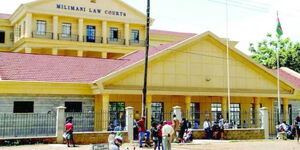The Housing Levy debate became a complex and controversial issue, even as President William Ruto on Sunday, June 4, reiterated his stand to impose a 3 per cent deduction or at most Ksh2,500 from all salaried employees for the funding of his affordable housing project.
Ruto's proposal was yet again met with mixed reactions with Kenya Kwanza MPs supporting it and their counterparts in the Raila Odinga-led Azimio la Umoja MPs opposing it.
Those who support the Housing Levy argue that it is a necessary measure to address the country's housing deficit. They point out that Kenya has a housing deficit of over two million units, and that the government was unable to meet the demand for housing through its own resources.
The Kenyan Kwanza MPs argue that the housing levy will provide the government with the resources it needs to build more housing units and provide affordable housing to Kenyans.
While those who oppose the Housing Levy argue that it is a regressive tax that will disproportionately burden low-income earners.
They stated that the levy will discourage investment and economic growth, and advised the government to focus on improving the efficiency of its housing programs rather than raising taxes.
However, going by their current and previous proposals, policies from both Ruto and Raila camps aligned in describing the need for a housing fund. Here are five policies from Raila that are in tandem with Ruto's vision.
1. Housing Crisis
Ruto and Raila agree that the country is facing a housing crisis fomented by a deficit of over 2 million units, and the demand for housing is growing rapidly.
In his 2022 manifesto, Raila had promised that the government had been unable to meet the demand for housing through its own resources while the private sector had been unable to fill the gap.
"Urbanisation is increasing due to rural-urban migration and population growth leading to high demand for housing, social, recreational, and commercial amenities. The high demand has outstretched the provision of the requisite infrastructure, social services, and security. Therefore, there is a need for a more deliberate and sustainable approach towards urbanization.
"Affordable housing is a fundamental human right guaranteed in the Constitution of Kenya 2010 and it is a pillar to human development. Investment in housing impacts the national income by igniting and sustaining forward and backward linkages through additional investment in construction materials, transportation and related building materials.
In his address on the subject matter on Wednesday, May 24, President Ruto noted that the country was experiencing rapid urbanisation, with the urban population growing at a rate of 4.4 per cent per year.
"This is putting a strain on the country's housing stock. The cost of land in Kenya is very high, making it difficult to build affordable housing. The cost of construction in Kenya is also very high, due to factors such as the high cost of materials and labour," Ruto observed.
On his part, Raila noted that many Kenyans do not have access to finance to buy or build a home, which drove many to live in inhuman conditions while others were spending a large proportion of their income on rent, leaving them with less money to spend on other necessities such as food and education.
Raila stated that people living in informal settlements are at a higher risk of contracting diseases such as malaria, respiratory infections, and diarrhea, as a result of the housing crisis.
2. Imposing Housing Levy
Fundamentally, both Ruto and Raila agreed on setting up a Housing Levy but disagreed on the terms of contribution, especially on the rate that will be contributed.
The President proposed a housing levy of 3 per cent of monthly income or a maximum of Ksh2,500 to be deducted from all employees’ salaries to fund a housing project.
For example, if your monthly income is Ksh100,000, you will be required to pay Ksh2,500, and not Ksh3,000 in Housing Levy.
Similarly, your employer will contribute a similar amount, Ksh2,500, making it Ksh5,000 per month, which will be remitted by employers to employees' accounts.
Proponents argued that the housing levy could lead to an increase in housing supply, as the government will have more resources to invest in housing projects.
Housing Principal Secretary Charles Hinga noted that the housing levy could lead to lower housing prices, as the government will be able to provide more affordable housing options.
"You cannot buy more than one house," Housing PS Charles Hinga warned those planning to take advantage of the Affordable Housing Programme.
Opponents stated that the housing levy will be an additional tax burden on Kenyans, and could lead to higher prices for goods and services.
While campaigning during the August 2022 Presidential Election, Raila also proposed a housing levy but capped it at 1.5 per cent of an individual's monthly income. He argued that the fund would be used to build affordable housing units for low and middle income Kenyans.
3. Creating Employment Opportunities through Affordable Housing
Both the Head of State and the opposition leader aimed to create jobs during the construction of the affordable housing projects.
"The Affordable Housing Programme will directly create one million jobs, but another three hundred thousand jobs will be created through supplies in which young people will be contracted," State House Spokesperson Hussein Mohammed explained in defenceof Ruto's plan
"It also spurs economic growth by providing labor-intensive jobs to many young people. The opportunity to use housing to generate employment as it is a very labor-intensive sector. The construction of one housing unit can generate between 3 and 5 new jobs from other jurisdictions," Raila explained during the campaign period in 2022.
Raila also promised to establish a scheme for first-time homeowners who are either seasoned employees, new job entrants or (Micro, Small and Medium Enterprises) MSMEs startup owners similar to Ruto's Group Loan Facility under his flagship programme, the Hustler Fund.
"I will adopt the Affordable Housing Program Jua Kali Production Manual for purposes of ring-fencing the 69 items earmarked for juakali production with the aim of expanding local manufacturing. Connect jua kali manufacturers with orders for the doors, windows, nails, hinges, and all the other 69 items, under the Affordable Housing Programme," Raila promised.
4. Creation of a National Fund
The two leaders, Raila Odinga and William Ruto had previously proposed the creation of a National Fund to help address Kenya's housing crisis but displayed different visions on its structure and purpose.
Ruto suggested a National Housing Development Kitty that would be funded by a mix of government and private sector resources. The corporation would be responsible for developing and managing affordable housing projects across the country.
"Those who are giving us loans like the Chinese, have had their citizens contribute and create a national fund from where they have been able to lend to nations," Ruto stated.
Raila also expressed similar ideas during 2022 election campaigns, when he talked about ensuring that Kenya established a national financial reserve like the Western nations.
The Orange Democratic Movement (ODM) Party Leader defined a national financial reserve as a collection of assets that a country holds to help stabilise its economy.
Reserves can include foreign currency, gold, and other assets. Countries use their reserves to intervene in foreign exchange markets, to finance government spending, and to provide liquidity to the financial system.
Raila also explained that there are a number of reasons why countries hold national financial reserves. One reason is to help stabilize the exchange rate. If the value of the country's currency is under pressure, the central bank can use its reserves to buy back the currency, which will help to stabilize the exchange rate.
Another reason to hold reserves is to finance government spending. If the government needs to borrow money, it can use its reserves to do so. This can help to reduce the amount of debt that the government needs to issue.
The ODM Party Leader also noted countries hold reserves to provide liquidity to the financial system. If there is a financial crisis, the central bank can use its reserves to inject liquidity into the system, which can help to prevent a collapse of the financial system.
5. Affordable Housing Purchase and Distribution Arrangement
Currently, the government of Kenya has a number of programs in place to help Kenyans purchase affordable housing. These programs include the National Housing Development Fund (NHDF), which is a government-owned fund that provides loans at a subsidised rate to Kenyans to help them purchase homes.
There is also the Kenya Mortgage Refinance Company (KMRC), a government-owned company that provides loans to banks and other financial institutions at subsidised rates, which makes it easier for banks to provide mortgages to Kenyans.
Government-Sponsored Housing Scheme (GSHS), on the other hand, provides affordable housing to Kenyans by building and selling homes at a subsidised price.
In addition to these government programs, there is the Kenya Private Developers Association (KPDA), an association of private-sector developers who are working to provide affordable housing to Kenyans. The KPDA has developed a number of affordable housing projects that are available to Kenyans.
While Kenya Mortgage Guarantee Company (KMG), which is a private sector company provides mortgage guarantees to banks and other financial institutions. These guarantees make it easier for banks to provide mortgages to Kenyans.
In their plans, Ruto and Raila proposed to work with both government agencies and investors in the private sector to achieve the much-needed housing, and sell them to the most needy group, that is the people living in informal settlements.
"In the affordable housing sector, and Azimio government will seek more investments to ensure that the Article 43 right to accessible and adequate housing is realized progressively. Rapid population growth, an estimated annual rate of 8.3 per cent equals increased demand for adequate and affordable housing, infrastructure and related amenities.
"Developers focus on the upper middle class leaving a shortage that is more acute for Kenyans in lower-income segments, and the quality of what is available does not promote the standard of living that our citizens deserve. 56 per cent urban population (approx 6.4M people) live in slums," Raila stated.
While addressing the media on at the State House, PS Hinga stated that the houses will be distributed to employees on a need and priority basis. Housing PS Hinga explained that the houses will be in different capacities, including studios, one to three bedrooms.












